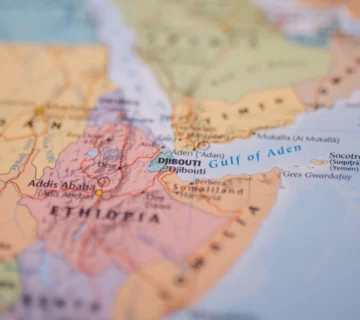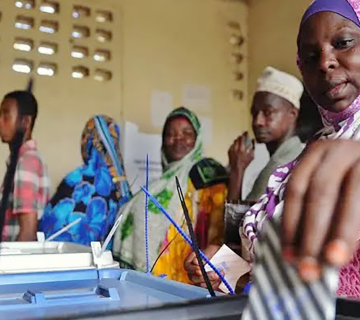In many respects, Somalia might be qualified as the Afghanistan of the Horn of Africa based on its troubled political history at least 1991 and possibility of falling back to Islamist insurgents. The country has experienced a long period of political instability and state fragility, fallen to an Islamist ‘government’, experienced military invasion (of Ethiopian forces) and is in the final stages of international efforts at state-building. However, just like Afghanistan, Somalia exhibits worrying state fragilities which make it possible for the imminent withdrawal of AMISOM forces to be followed by collapse of government and the return of the al Shabab to Mogadishu to recapture power.
Unstable and Dysfunctional Government
While Somalia has been through elections and power transitions since 2004, the democratic transitions may not be a good indicator of long-term stability and security. The Federal Government of Somalia is saddled with corruption, poor delivery of basic service delivery, huge budget deficits, insecurity due to rampant attacks on civilian population and government facilities and functionaries by al Shabab and other militant groups. Somalia’s government is further characterized by weak administrative structures which for instance, jeopardize the rule of law and access to justice. The civilian population resorts to al Shabab courts and administration, sometimes travelling from Mogadishu to al Shabab held territories for such services. Similar challenges are witnessed in the realm of revenue collection where al Shabab is claimed to collect more taxes than the government, enabling the extremist group to stay financially afloat and sustain its operations. The government is instead significantly dependent on foreign development and humanitarian aid which depend on foreign political interests that further alienate the national government (ruling elites) from the local population. On its part, al Shabab has sustained a narrative which paints the federal government as a stooge for foreign interests, ineffective and ‘immoral’ due to high levels of corruption and plunder by ruling elites. The al Shabab propaganda seems to resonate widely across Somalia, further damaging the government’s legitimacy and domestic support.
Limited Territorial Control
The Federal Government of Somalia and the governments of Federal Member States wield less territory compared to al Shabab, which retains control over larger sections of central and southern Somalia. Al Shabab thus administers spaces and population in the territory it controls which has allowed the group to cut off federal government presence, services and legitimacy over respective regions and populations. The federal government is in constant struggle to increase its penetration and control of territory while al Shabab is mostly concerned with retaking civilian population centers or key urban areas, and Mogadishu.
Weak National Military and Security Agencies
The Somali National Army’s capacity and preparedness to handle the transition from AMISOM remains in doubt due to reports of being under-trained, under-equipped and ill-motivated. The military may not be able to effectively play its defense and security role in the increasingly polarized political environment in Somalia. There have been instances of military bases being overrun by al Shabab and the force suffers clan fractures which were evident in April 2021, when sections of the military backed different political leaders based on their clans as opposition forces clashed with government forces after the attempted mandate extension by the current Somali President Mohamed Abdullahi Mohammed.
On the other hand, the intelligence wing of Al Shabaab, Amniyaat, has infiltrated sensitive quarters of the federal government of Somalia. Amniyat has infiltrated almost every key government installation, institution and protocols including top national security agencies, parliament, and the public service at both federal and state levels. Al Shabab has thus been able to gather critical intelligence on government operations, capacities, weaknesses and security capabilities as well as carry out assassinations of senior government officials.
US and AMISOM withdrawal
Under President Donald Trump, the United States begun and completed withdrawal (repositioning) of its troops from Somalia in early January 2021. The United States has been responsible for training and capacity building special operations units in the nascent Somali National Army. AMISOM is also scheduled for complete withdrawal from Somalia in December 2021, after nearly 15 years of bolstering the capacity of Somali security agencies and deterring al Shabab insurgency.
The withdrawal of both the US and AMISOM forces will create a critical capacity gap in the Somali National Army as well as significant military and territorial vacuums which Somali security forces may not effectively fill thus shifting the advantage to al Shabab.
Considered together with the recent al Shabab assassination of senior federal and regional government officials, overrunning of Somali military bases, and the resurgence of al Shabab, full AMISOM exit as scheduled in December 2021 is highly likely to lead to the fall of the Somali government to Islamist insurgents due to prevailing state fragilities.
Edmond J. Pamba is a Researcher at the HORN Institute.
Photo: Somali National Army soldiers take part in a training exercise on March 28, 2013, at the AMISOM Jazeera Training Camp on the outskirts of Mogadishu, Somalia. (Photo Credit: Phil Moore/AFP/Getty Images)
The contents of this article are copyright of © The HORN Institute 2022. All rights reserved. Any redistribution or reproduction of part or all of the contents in any form and for whatever reason is prohibited. You may use the content of this article for personal reasons, but acknowledge the website as the source of the material.



